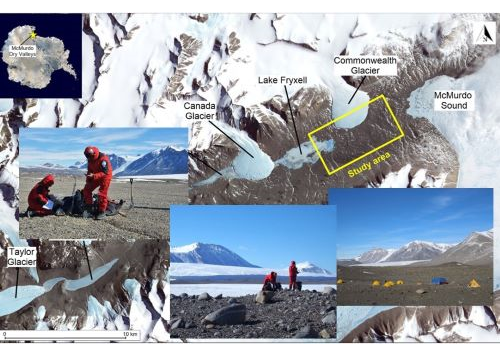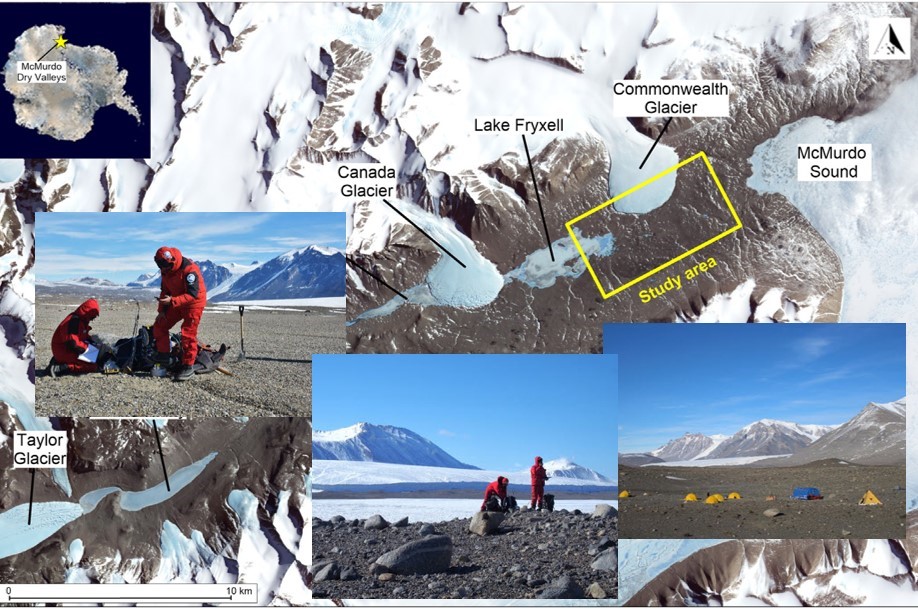Le zone peri-costiere dell’Antartide, la più estesa area priva di ghiaccio del continente antartico dove le condizioni atmosferiche hanno generato uno degli ambienti più estremi del Pianeta, stanno subendo il degassamento dal permafrost.
Nelle Dry Valleys, zone peri-costiere dell’Antartide, la degradazione del permafrost (suolo ghiacciato) causata dal riscaldamento globale favorisce i fenomeni di degassamento che potrebbero estendersi lungo gli oltre 24.000 km di costa del continente antartico. È quanto è emerso dallo studio ‘Antarctic permafrost degassing in Taylor Valley by extensive soil’, condotto nell’ambito del progetto SENECA (SourcE and impact of greeNhousE gasses in AntarctiCA), finanziato dal Programma Nazionale di Ricerche in Antartide (PNRA) e coordinato dall’Istituto Nazionale di Geofisica e Vulcanologia (INGV).
“La ricerca, che costituisce la prima campagna geochimica estensiva condotta nel continente Antartico, è frutto della collaborazione internazionale tra l’INGV, il GNS Science (Nuova Zelanda), l’Università di Otago (Nuova Zelanda), l’Università di Oslo (Norvegia), l’Università Sapienza di Roma, l’Università di Padova e l'Istituto di geologia ambientale e geoingegneria del Consiglio nazionale delle ricerche (Cnr-Igag)”, sottolinea Fabio Florindo, dirigente di ricerca INGV.
“Le zone dell’Antartide note come McMurdo Dry Valleys, situate nel settore orientale, a circa 100 chilometri dalla base americana di McMurdo e neozelandese Scott Base costituiscono la più estesa area priva di ghiaccio del continente antartico dove la scarsissima umidità, le temperature gelide (tra -14 °C e -30 °C) e venti catabatici fino a 320 km/h hanno generato uno degli ambienti più estremi del Pianeta”, spiega Alessandra Sciarra, ricercatrice INGV.
Recenti studi condotti nelle regioni polari nell’emisfero nord hanno rivelato che la stabilità del permafrost gioca un importante ruolo nell’attuale ciclo del carbonio, dal momento che può intrappolare considerevoli quantità di gas serra. Attualmente, il fenomeno del riscaldamento globale favorisce il rapido riscaldamento del permafrost artico con il conseguente rilascio di notevoli quantità di gas serra. Tuttavia, nelle regioni antartiche questo fenomeno non era stato ancora sufficientemente studiato e valutato.
“In Antartide, le McMurdo Dry Valleys rappresentano circa il 10% del suolo deglaciato dell’intero continente e, così come avviene per le regioni polari del nord, tendono a riscaldarsi anche se più lentamente. Durante l’estate australe del 2019 - 2020, è stata effettuata la prima campagna geochimica estensiva su una superficie di circa 22 km2 nella Taylor Valley. L’indagine ha permesso la misura in superficie della concentrazione di un’ampia gamma di gas, tra cui anidride carbonica, metano e idrogeno, nel suolo e del flusso di CO2 al fine di identificare le vie preferenziali di risalita per i fluidi profondi e valutarne i meccanismi di migrazione”, prosegue Livio Ruggiero, ricercatore INGV e responsabile scientifico del progetto SENECA.
“Confrontando questi dati con i pochi dati pregressi a disposizione”, aggiunge il ricercatore, “è stato osservato un incremento nel flusso dell'anidride carbonica, stimato pari a circa 15 tonnellate al giorno su un’area di 21.6 km2. Infatti, l’emissione di CO2 calcolata durante il periodo estivo è circa 448.5 tonnellate al mese per l’intera area”.
“La presenza contemporanea di anomalie di più specie gassose nel suolo delle McMurdo Dry Valleys ha permesso l’individuazione di zone caratterizzate dallo scioglimento del livello attivo del permafrost e dove la presenza di strutture tettoniche e/o fratture permette a tali gas di migrare verso la superficie. I dati preliminari suggeriscono la presenza di elevate quantità di gas disciolti nel sistema di “brine” in sovrapressione al disotto del permafrost”, prosegue Giancarlo Ciotoli, ricercatore Cnr-Igag.
“Nelle Dry Valleys la degradazione del permafrost causata del riscaldamento globale favorisce i fenomeni di degassamento che potrebbero non limitarsi alla Taylor Valley ma estendersi anche lungo gli oltre 24,000 km di costa del continente antartico. I risultati della ricerca hanno evidenziato la necessità di effettuare ulteriori indagini estensive per valutare adeguatamente le emissioni di gas serra in regioni caratterizzate dalla presenza di permafrost. Infine, questo lavoro ha prodotto una mappa delle emissioni di CO2 che potrà costituire un punto di partenza per future ricerche finalizzate alla valutazione dell’origine di questi gas e al monitoraggio delle emissioni di gas serra rilasciati dal permafrost antartico”, conclude Livio Ruggiero.
La ricerca è stata pubblicata sulla rivista Science of the Total Environment.
Citazione dello studio: L. Ruggiero, A. Sciarra, A. Mazzini, F. Florindo, G. Wilson, M.C. Tartarello, C. Mazzoli, J.T.H. Anderson, V. Romano, R. Worthington, S. Bigi, R. Sassi, G. Ciotoli, Antarctic permafrost degassing in Taylor Valley by extensive soil gas investigation, Science of The Total Environment, Volume 866,
2023,161345, ISSN 0048-9697, https://doi.org/10.1016/j.scitotenv.2022.161345.
Link: https://www.gns.cri.nz/
Otago https://www.otago.ac.nz/
Oslo https://www.uio.no/english/
---
GLOBAL WARMING |Emission of significant quantities of greenhouse gases from the perennially frozen ground has been detected in Antarctica
The peri-coastal areas of Antarctica, the largest ice-free area of the Antarctic continent where atmospheric conditions have generated one of the most extreme environments on the planet, are undergoing degassing from the permafrost.
In the Dry Valleys, peri-coastal areas of Antarctica, the degradation of permafrost (frozen ground) caused by global warming favours degassing phenomena that could extend along the over 24,000 km of coast of the Antarctic continent. This is what emerged from the study 'Antarctic permafrost degassing in Taylor Valley by extensive soil', conducted within the SENECA (SourcE and impact of greeNhousE gases in AntarctiCA) project, funded by the National Antarctic Research Program (PNRA) and coordinated by the Istituto Nazionale di Geofisica e Vulcanologia (INGV).
“The research, which constitutes the first extensive geochemical survey conducted in the Antarctic continent, is the result of the international collaboration between INGV, GNS Science (New Zealand), the University of Otago (New Zealand), the University of Oslo (Norway), the Sapienza University of Rome, the University of Padua and the Institute of Environmental Geology and Geoengineering (IGAG) of the National Research Council (IGAG-CNR)”, points out Fabio Florindo, research director at INGV.
“The areas of Antarctica known as the McMurdo Dry Valleys, located in the eastern sector, about 100 kilometres from the American research station of McMurdo and New Zealand's Scott Base, constitute the largest ice-free area of the Antarctic continent where the very low humidity, the freezing temperatures (between -14 °C and -30 °C) and katabatic winds of up to 320 km/h have generated one of the most extreme environments on the planet”, explains Alessandra Sciarra, researcher at INGV.
Recent studies conducted in the polar regions of the northern hemisphere have revealed that permafrost stability plays an important role in the current carbon cycle, as it can trap considerable amounts of greenhouse gases. Currently, the phenomenon of global warming favours the rapid warming of the Arctic permafrost with the consequent release of significant quantities of greenhouse gases. However, in the Antarctic regions this phenomenon had not yet been sufficiently studied and evaluated.
“In Antarctica, the McMurdo Dry Valleys represent about 10% of the deglaciated ground of the entire continent and, as is the case with the northern polar regions, they tend to warm even if more slowly. During the southern summer of 2019 - 2020, the first extensive geochemical campaign was carried out on an area of approximately 22 km2 in the Taylor Valley. The investigation allowed the surface measurement of the concentration of a wide range of gases in the soil, including carbon dioxide, methane and hydrogen, and of the CO2 flux in order to identify the preferential routes of ascent for deep fluids and evaluate the mechanisms of migration”, continues Livio Ruggiero, researcher at INGV and principal investigator of the SENECA project.
"Comparing these data with the few previous data available", adds the researcher, "an increase in the flow of carbon dioxide was observed, estimated at about 15 tons per day over an area of 21.6 km2. In fact, the CO2 emission calculated during the summer period is about 448.5 tons per month for the entire area".
“Furthermore, the simultaneous presence of multiple gas anomalies in the soil of the McMurdo Dry Valleys has allowed the identification of areas characterised by thawing of the active permafrost layer and where the presence of tectonic structures and/or fractures allows these gases to migrate toward the surface. This preliminary data suggests the presence of high quantities of dissolved gases in the over-pressurized subsurface brine system below the permafrost”, continues Giancarlo Ciotoli, researcher at the CNR-IGAG.
“In the Dry Valleys, the degradation of the permafrost caused by global warming favors degassing phenomena which could not be limited to the Taylor Valley but also extend along the over 24,000 km of coast of the Antarctic continent. The research findings highlighted the need for further extensive surveys to adequately assess greenhouse gas emissions in regions characterised by the presence of permafrost. Finally, this work has produced a map of CO2 emissions which could constitute a starting point for future research aimed at evaluating the origin of these gases and at monitoring the greenhouse gas emissions released by the thawing permafrost", concludes Livio Ruggiero.
Study citation: L. Ruggiero, A. Sciarra, A. Mazzini, F. Florindo, G. Wilson, M.C. Tartarello, C. Mazzoli, J.T.H. Anderson, V. Romano, R. Worthington, S. Bigi, R. Sassi, G. Ciotoli, Antarctic permafrost degassing in Taylor Valley by extensive soil gas investigation, Science of The Total Environment, Volume 866,
2023,161345, ISSN 0048-9697, https://doi.org/10.1016/j.scitotenv.2022.161345.
Link: https://www.gns.cri.nz/
Otago https://www.otago.ac.nz/






